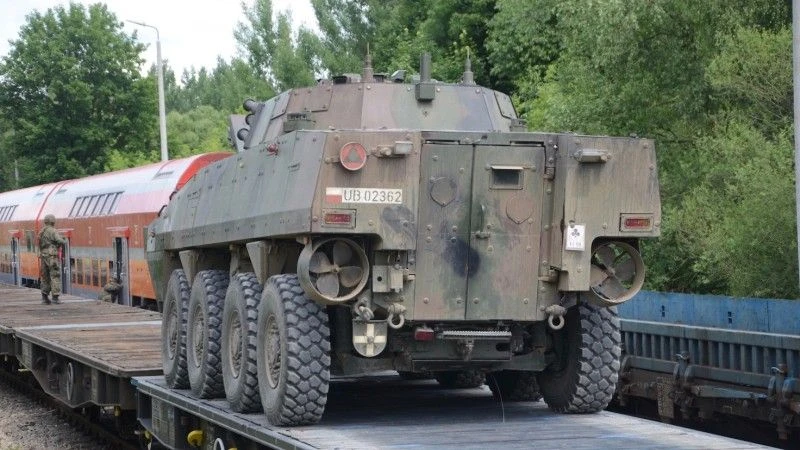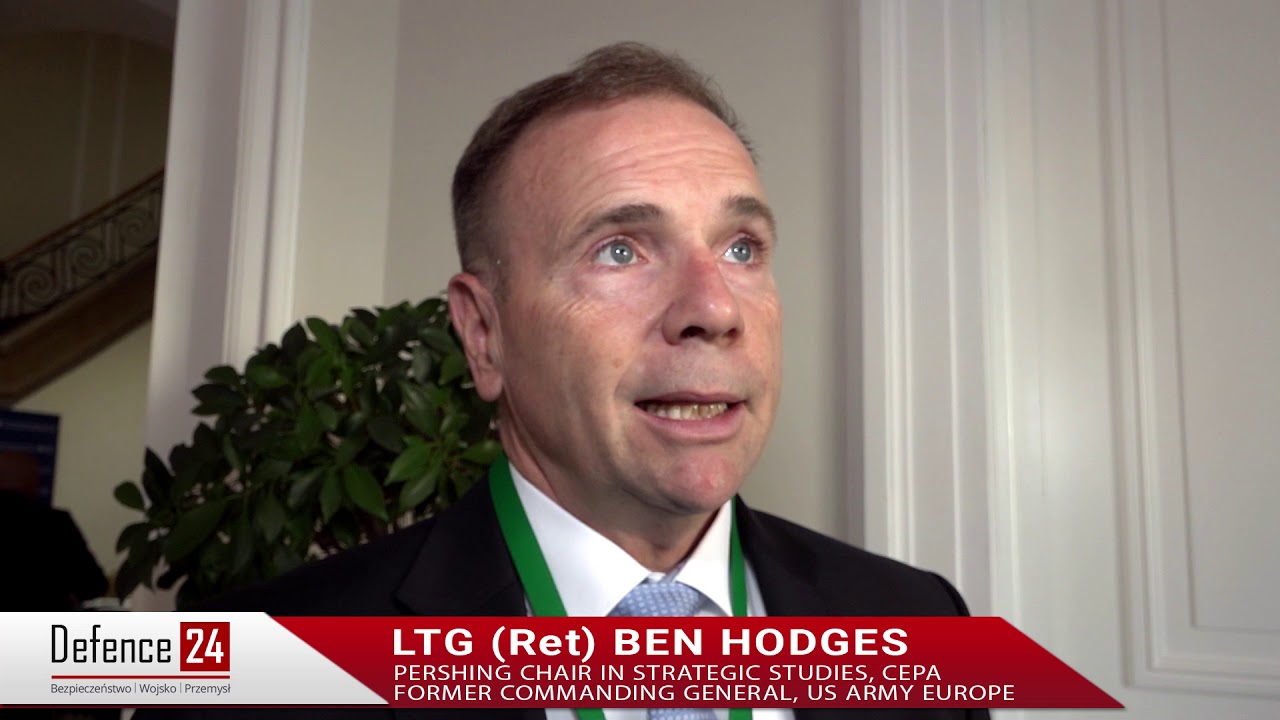Defence Policy
Gen. Hodges: Europe must be open to the movement of NATO forces

The most difficult part is getting the politicians convinced. It’s all about understanding that improving military mobility is vital to NATO and helping them come together on a common view of threats on NATO’s Eastern Flank – as general Ben Hodges, former commander of US Army Europe said in an interview with Defence24.pl, on challenges to improving the mobility of NATO forces.
Maciej Szopa: General, you are the co-author of “Until Something Moves: Reinforcing the Baltic Region in Crises and in War,” a new report on challenges to the mobility of NATO forces, which will soon be released by ICDS and CEPA. Please tell me, why military mobility in Europe is so important?
General Ben Hodges: The ability to move forces quickly gives flexibility to our political leaders – thus they can implement their decisions rapidly, so that they are able to prevent or respond to a crisis, before actual conflict begins. We also need to be able to rapidly move forces during peacetime, and to cross borders with military equipment. Thanks to the above, our leaders will be able to send a signal to potential adversaries that they are ready to act. They will also be able to efficiently respond to a humanitarian crisis.

NATO forces’ mobility is an issue that had not been brought up until Russian aggression directed against Ukraine, in 2014. Then, things significantly changed. What have we been able to learn about military mobility, over recent years?
Prior to 2014 and the attack against Ukraine, and after the end of the Cold War, the mobility of forces in Europe had been a non-issue, since most of the people, nations, and even the US military had deeply believed that Russia would over the long term, become a partner. This is what we all wanted and rapidly crossing borders was not a matter brought up in talks during that period. Thus, new attention was focused on military mobility, in 2014, when we realized that we need to improve our ability to deter Russia from making a dire mistake – an attack against one of our allies.
NATO’s responsibility was to identify the requirements. Meanwhile, the European Union has an ability to change laws and procedures associated with border crossings and to improve local infrastructure and increase movement efficiency. I think that we have managed to make progress. The EU and NATO collaborate while the EU started one of the most important of its military mobility projects, within the framework of PESCO.
Are the steps made towards establishment of NATO mobility in Europe headed in the right direction? How do you assess them?
NATO and the EU have paid attention to these issues, so things are going the right way. We should remember though, that we have a long road ahead. If assets are not available and if required changes are not implemented, then not much can be done. Fortunately for us, we are in a place where the urgency and the meaning of these matters are both appreciated – which is a novelty when compared to the situation we were experiencing a few years back. We really need to work hard and with urgency, on this aspect of deterrence.
What creates most of the difficulties in that process?
The most difficult part is getting the politicians convinced. It’s all about understanding that improving military mobility is vital to NATO and helping them come together on a common view of threats on NATO’s Eastern Flank. Some states, such as Poland, Romania or the Baltics understand this well. But the further West you go in Europe, the lesser the understanding is – the views on the situation in the East differ a lot. We need to persuade our leaders to understand what the needs are, and then to set corresponding priorities when it comes to allocation of resources.
What are the key obstacles to achieving a satisfactory level of military mobility in Europe? We have already heard a lot on harmonizing regulations, but what about the infrastructure, and movement coordination by various Allied Armies?
As we discuss in our report, you can divide military mobility challenges into 3 major areas: (1) infrastructure gaps; (2) gaps in Command and Control (C2) and organizational coordination of movement; and (3) non-coherence in border crossing procedures across many countries. I believe points 2 and 3, though major challenges, are easier to address and fix. It’s developing proper infrastructure to enhance military mobility, which will remain a long-term challenge. That said, all 3 areas need urgent attention and cooperation by NATO and the EU.
Having proper bridges and river crossing capabilities at one’s disposal and mutual communication allowing for managing cross-border traffic and the infrastructure as a whole, are key factors contributing to increasing of mobility in Europe. Railways in Europe, for instance, do not have enough capacity to carry a sufficient quantity of heavy vehicles. If the Russians, or other potential adversaries come to the conclusion, at some point, that we cannot move rapidly – as quickly as them or quicker, they could be tempted to carry out a minor attack against one of our allies. Should they do this without any consequences, with NATO reinforcements not being provided in a timely manner, this would be a proof that the alliance is unable to protect its members. Thus, they would seriously weaken the alliance – this, obviously, is their goal. To prevent that, we need to maximize the European area for the movement NATO forces.
What role is played by the railway infrastructure, and what role can be associated with the road network, in case of large military movements?
The railway infrastructure is the most important asset here. The main reason why main battle tanks and other heavy equipment should be moved by trains stems from the fact that if moved this way, the movement can be much faster. Main battle tanks, when on the road, can only move at their top speed that is not really high, when compared to a train, truck or other military wheeled vehicles. Furthermore, the tank, when moving on the road, also has a detrimental impact on the road surface and it consumes a lot of fuel. Efficient road networks and fuel are the things that you want to have at your disposal. Thus, you need to move forces with trains, to the area of operations where they shall be unloaded.
The very same happened during the World War II for instance, when the Germans were moving their tanks with the use of trains almost into the battle zone. This was motivated by speed, fuel savings and road limitations. So now the situation is similar. Indeed, you can also move main battle tanks with the use of trailers today, but you can only move one main battle tank per trailer. I think it is important to add here that the acquisition of such semi-trailer tank carriers would be a good investment for nations willing to increase financing of their armed forces, but who are not interested in quantitatively enlarging their combat units. They could procure numerous transport assets and form transport battalions to support NATO. Thus, they would contribute to enhancement of NATO’s movement capability. This is something that we really need!
The report you co-authored asserts harbor infrastructure in the Baltic area is insufficient. How could improvements be implemented there?
This can be done, and it is a part of the responsibility of individual nations to improve the capacity within the scope of unloading and deploying forces from the US, and Canada, and other allied nations. This is a part of the Host Nation Support requirements. One should also remember that should a crisis emerge, all of the Baltic harbors, up to Gdansk, will be within reach of the Russian missiles, especially those stationed in the Kaliningrad region. Should we experience a conflict, the Baltic Sea would become a body of water where kinetic battle would be waged.
Thus, we need to have a closer look at the protection of shipping and movement of forces on the water on the Baltic Sea, and on the harbors themselves as well. When it comes to the latter, we also need to take the cybersecurity into account. They could be disabled easily by both a cyber-attack and a missile strike. Thus, not only is missile defense needed, cyber-defense is equally important. I do think that Germany and the Netherlands could play a role that would be much more significant than now in this area.
Is increasing mobility of NATO forces only aimed at responding to threats in NATO’s eastern direction?
When it comes to fast deployments, it’s not just about NATO and Russia - it is also about the ability to respond to other potential crises areas. In the Balkans or in Libya for example. NATO assets would variously need to be airlifted, moved by railways or roads. Considering challenges of international border movements in Europe, during the current coronavirus epidemic, we can see that though infrastructure is priority one, just how far we still need to go on fixing diplomatic procedures and Coordination and C2 of cross border movements.
Thank you for the conversation.
Military Mobility is a key issue of a new report by the International Centre for Defence and Security (ICDS), and the Center for European Policy Analysis (CEPA), co-authored by general Ben Hodges, which will soon be released to the public. Its title, “Until Something Moves: Reinforcing the Baltic Region in Crises and in War”.
